[Pan Am 103 Series]
Adam Larson / Caustic Logic
September 29 2009
Last update 10/22
Among the evidence used to implicate Libyan al Megrahi for the bombing of Pan Am 103, the strongest, most tangible, most sciencey, is the small but identifiable fragment of timer circuit board though by some to have triggered the bomb that brought the plane down on Lockerbie Scotland in December 1988. What we know is the style is the same, circuit-wise, as a MST-13 board, made by a Swiss company, Mebo, in a limited run of 20 (plus three prototypes) for Libyan intelligence in the mid-1980s. Notwithstanding the likelihood of anything surviving the reported type of explosion, fact is little is alleged to survive, and I will proceed on the notion that it's possible for this to be genuine, but far from a foregone conclusion.
In the course of a discussion thread started at the JREF forum by member Rolfe, examining whether the timer fragment was planted, I was able to establish some visual patterns helpful to understanding the issue. There are already numerous documented, eyebrow-raising anomalies with how this historic evidence has been handled and by whom, and I will address these elsewhere - here I hope to just make a quick post to convey, mostly with pictures, what I thought might be an important piece of new information I discovered looking at some jpeg images, available online and purporting to be genuine trial-related evidentiary photos. One may note a color shift from the first to view to the last, with an original faintly blue-tinted gray later showing as tinted blue all over the image. The board's color is referred to by all who speak of it as "green." The shape and layout of the fragment as seen in each photo, however, remains consistent enough, steadily holding the known shape of Mebo's MST-13 board.
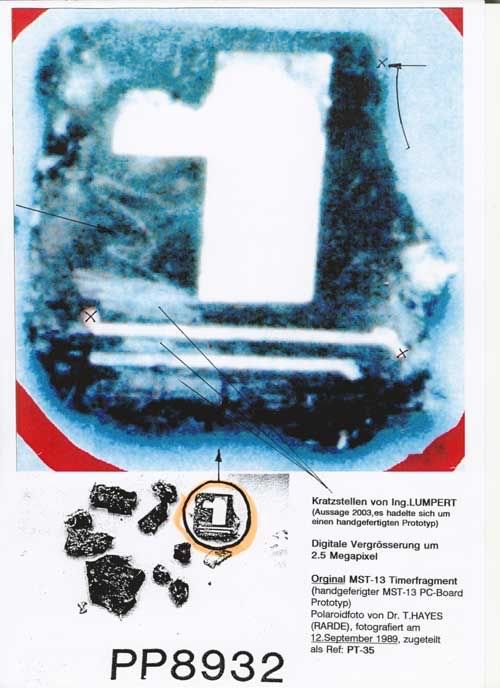 < The first, chronologically, shows a battered collar from a "Slalom" brand shirt, from which were supposedly removed some fragments, the interesting one of which is visible, blown-up, at left. This poster is annotated, in Dutch it seems, and attributes this photo to Dr. Thomas Hayes, RARDE scientist, on September 12 1989. For convenience, I'm using this to identify the shot.
< The first, chronologically, shows a battered collar from a "Slalom" brand shirt, from which were supposedly removed some fragments, the interesting one of which is visible, blown-up, at left. This poster is annotated, in Dutch it seems, and attributes this photo to Dr. Thomas Hayes, RARDE scientist, on September 12 1989. For convenience, I'm using this to identify the shot. 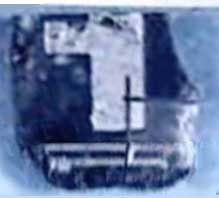 > The next is a file photo shown on ABC News in Nov. 1991 by FBI agent James "Tom" Thurman. This was presumably taken at the time of his June 15 1990 identification of the fragment as from a MST-13. There is plenty of confusion also as to whether he actually inspected the fragment or a photo of it, but here I'll just share his publicized hard copy, stretched to the same proportions as the exhibit photo (below), from Gideon Levy's totally amazing (but partly Dutch) Lockerbie Revisited video. Note the deep cuts, meeting at a right angle in the lower right of the touch pad. This does not seem to be present in the older photo.
> The next is a file photo shown on ABC News in Nov. 1991 by FBI agent James "Tom" Thurman. This was presumably taken at the time of his June 15 1990 identification of the fragment as from a MST-13. There is plenty of confusion also as to whether he actually inspected the fragment or a photo of it, but here I'll just share his publicized hard copy, stretched to the same proportions as the exhibit photo (below), from Gideon Levy's totally amazing (but partly Dutch) Lockerbie Revisited video. Note the deep cuts, meeting at a right angle in the lower right of the touch pad. This does not seem to be present in the older photo. <
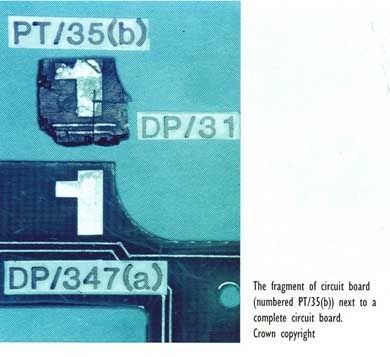 Exhibit PT35(b) photo - it's unknown at what time this was taken, but probably sometime around mid-1990. This is the most commonly seen view, as it clarifies just how open-and-shut the case is. Case being, does this dubious fragment match a board style similar to one usually made by... etc. The comparison model is reportedly an intact MST-13 confiscated from another Libyan intelligence agent, who had been planning some different bombing. It's supposedly just these two items side-by-side that allowed agent Thurman to make the connection.
Exhibit PT35(b) photo - it's unknown at what time this was taken, but probably sometime around mid-1990. This is the most commonly seen view, as it clarifies just how open-and-shut the case is. Case being, does this dubious fragment match a board style similar to one usually made by... etc. The comparison model is reportedly an intact MST-13 confiscated from another Libyan intelligence agent, who had been planning some different bombing. It's supposedly just these two items side-by-side that allowed agent Thurman to make the connection. Dr. Ludwig De Brackeleer, however, as a minor point of a detailed article largely about the fragment, disagreed:

There is a small glitch... It is obvious that the fragment PT35(b) does not come from one of the 20 machine-made MST13 timer delivered to Libya. The location of the T shaped touch pad, its absolute and relative dimensions do not match. Moreover the curvature of the fragment round edge equally differs!< I took the corner from the intact board in PT35(b) into Photoshop and applied the 'trace contour' filter. Beneath this I scaled a blowup of the fragment until the "1" shaped touch pad and as much as possible matched. It's quite a perfect fit in fact, minus a missing top portion, in addition to missing sections left, right, and below - not too surprising.
What I do find interesting is, well, this:
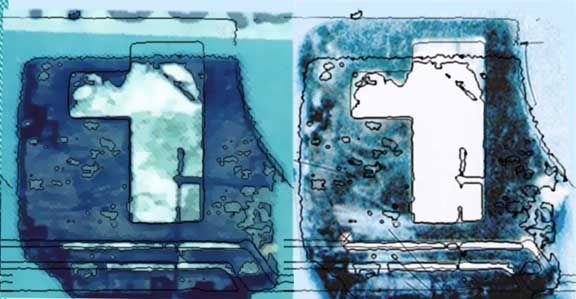
The earlier view is lacking the right-angle cut marks marking the lower right quadrant, and the later one is lacking the top portion straight across. Why on Earth would the top portion of a piece of evidence just go missing, and why would someone hack lines across it like that?
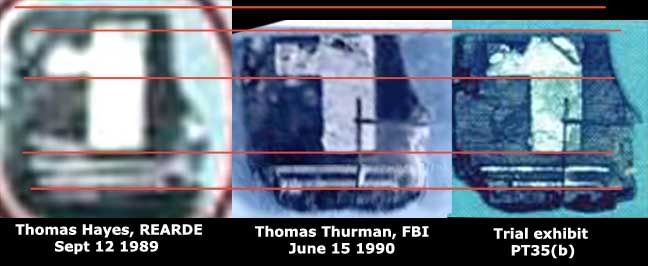
I had my own elaborate thoughts about some renegade scientist who smelled a rat swiping a chunk to hold as blackmail, using a safe deposit box and a team of Swiss lawyers, and was trying to tie in both the Mossad and an elaborate car chase through the plazas of Rome. Before I got this far however, JREF member Dan O, who seems to know a lot about electronics and investigations, offered a more plausible explanation:
In order to examine the cross section of the piece for identification of the material, it must be cleanly cut through a good part of the board. They need to make two cuts at right angles to map the orientation of the fibers in the epoxy board. Obviously some of the documentation for this chip is not present or this would have been explained. linkThat the gouges are deep into the board is evident looking at the middle view, Thurman's file photo. The portion above the horizontal slice is definitively darker than the section below, indicating slightly different planes catching the light differently. The board is either bent or completely cut through there. Where the vertical slice crosses the solder lines at bottom, it seems the solder was pulled along into a short connecting line. This is only hinted at in the later exhibit photo but quite pronounced in Thurman's picture. Below is a closer view, shown on 60 Minutes in 1999.

The missing top is a little more problematic. Dan O. seems to think a cross-section examination or something of that sort might explain the decapitation, but agreed with me that it's unusual to not present the evidence as whole as possible, with cut off parts either put back in or near their original places. Mebo's in-house designer of the MST-13 Ulrich Lumpert, In his highly unusual 2007 affidavit, mentioned a fragment cut up and presented as evidence. Lumpert claims he handed a non-operational brown-base prototype board to Swiss investigators for the Lockerbie investigation, and the next time he saw it was as the green/blue exhibit PT35(b) after it "had been sawed into two pieces apparently for forensic reasons."
Originally I had taken this to mean one small piece (the fragment) was presented, with the other piece (most of the board) chucked or whatever. However I'm now seeing a missing piece even of the small piece, and Mebo's "it was a fraud!" page seemed to be hinting at it when their site said the fragment itself, not the whole board, "was sawed into two parts in Scotland for forensic reasons." They specify that both were shown as evidence; "The large piece was given the police no. PT/35(b) and the smaller one was given the no. DP/31(a)." Looking back at the exhibit photo, it's got the label DP31 off to the side, right next to 35(b). Is the severed top shown off to the right, cropped off here along with the (a)? Mebo's take actually seems more on-target here after all. They seem to have decided it refers to the totally cut free lower-right corner section. The label does indeed point to that sector of the board, although it seems strange to log this as a separate piece of evidence, and it still leaves the top just gone.
The funny thing about this is, the Fraud page suggests first a full substitution - the forgers cut up Lumper's sample, as the original "brown" chip in the circled photo. Apparently they cut around the sideways letter "M" Lumpert scratched into it next to the "1" touch pad, to make sure he could recognize it later. In reality thisis more likely a fabric fiber like those hanging on the side, or perhaps some other illusion. But by Mebo's reckoning It wasn't til later that the perps realized it should be green, and this was after they'd cut up the brown one for "forensic reasons." In the exhibit photo "the larger piece," PT35(b), "was replaced with a green duplicate MST-13 fragment," carefully milled to mimick the original brown fake. This is known not so much by the color as the simple fact that "it can be clearly seen that no letter “M” was carved into it!" Oops! And for no particular reason I can discern, they decided the corner piece DP31(a) was actually from the brown original fake swapped back in to the swapped-out second replacement fake. Apparently they painted that section blue before fitting it in, so it would not stand out, since it doesn't. But you can't fool its designers, no! They see through any ruse no matter how imaginary it might be!
And nowhere in there, at least in graphics or English, did they make note of the missing top section as a glaring difference between the two fragments. For my part, I don't know what to make of it, and am willing to let it go as duly noted.


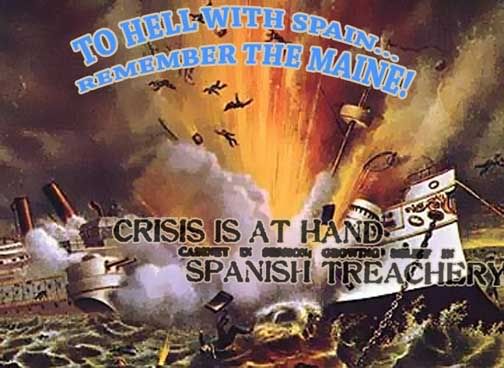
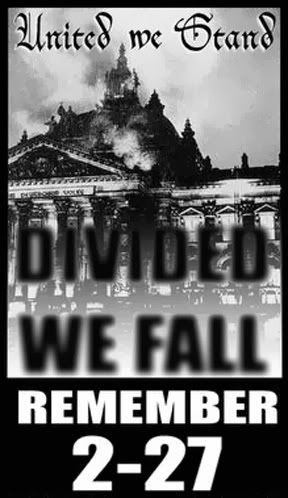


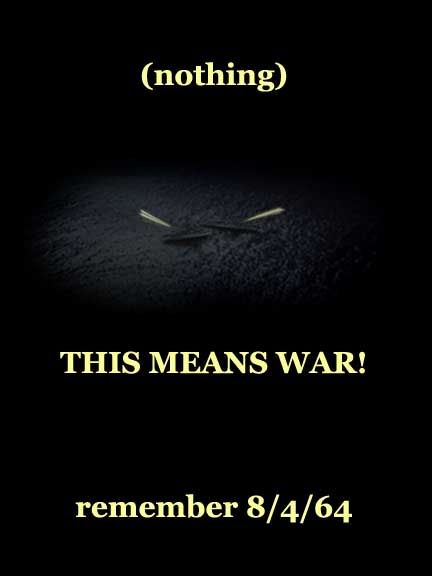






No comments:
Post a Comment